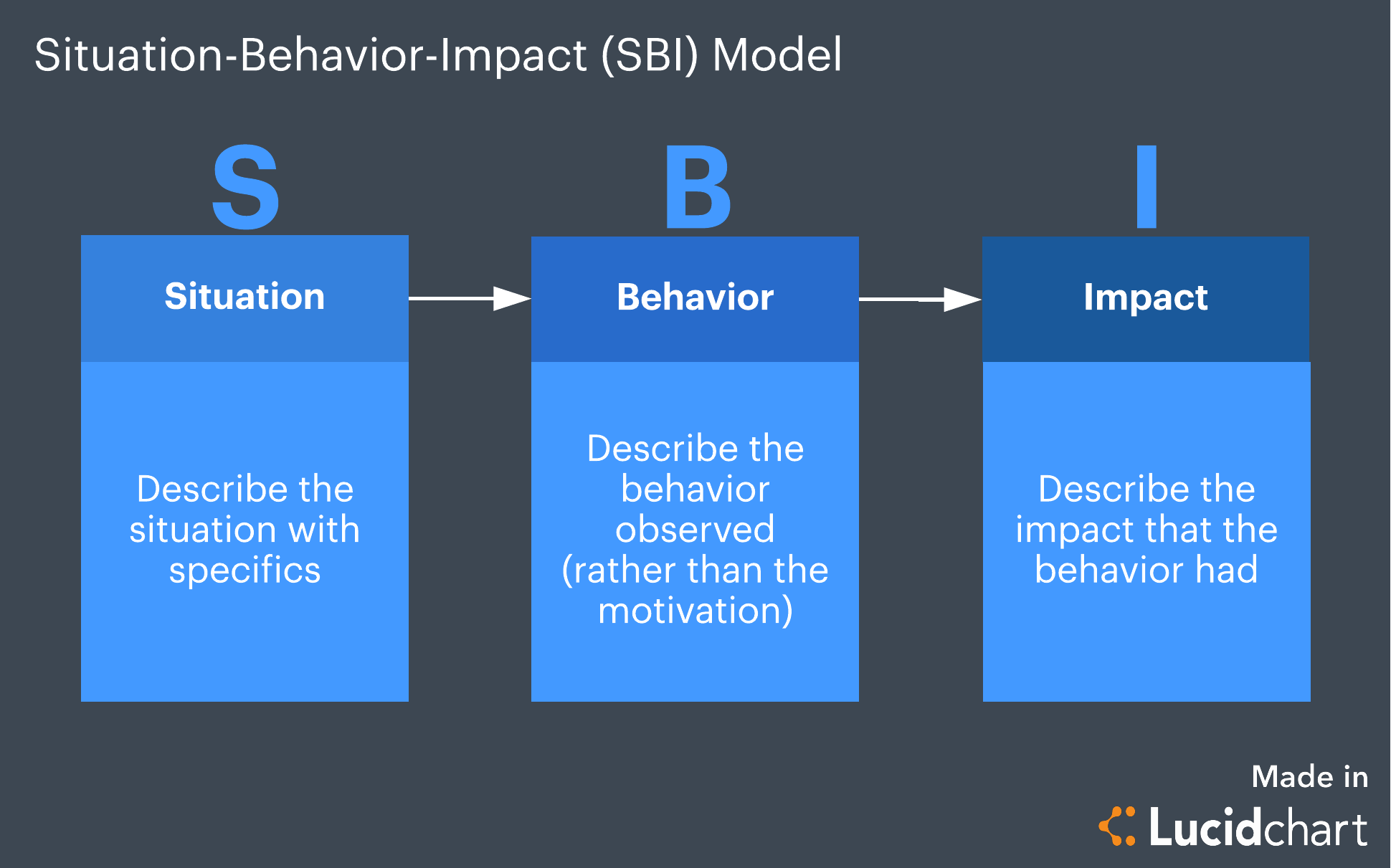
Powerful performance feedback models and how they can help your company
Reading time: about 7 min
Topics:
Whether it’s at work or from friends, feedback helps us improve both personally and professionally. In fact, 77.9% of employees would be more productive if they received positive feedback more frequently.
Unfortunately, only about half of employees say they actually receive regular performance feedback.
Studies show that companies benefit in numerous ways from having a reliable feedback process model, so why aren’t managers delivering feedback more often? Simply put: giving and receiving feedback can be hard.
Below we’ll review what makes feedback constructive and share some effective feedback models you can use to deliver better feedback to your employees.
What is feedback?
Performance feedback is delivering evaluative or corrective information to be used as a basis for improvement. Sounds easy enough, right? If the number of books, courses, and articles about performance feedback models is any indication, the answer is a definitive no. While the feedback itself may seem straightforward, its effectiveness depends upon its delivery.
What does effective feedback look like?
Feedback is generally divided into two types: positive and constructive (sometimes referred to as negative). And as much as we would all love nothing but positive feedback, there won't be any growth or improvement if we don’t gain insight into what needs change.
Effective performance feedback should be:
- Frequent and ongoing (rather than only offering feedback one time a year, such as performance reviews)
- Based on measurable facts
- Specific and targeted
- Actionable
- Timely
- Collaborative (leave time for the employee to ask questions)
Focus on behaviors and actions, not the person. At the end of your feedback session, you should discuss a time to follow up and track the individual’s progress.
The most effective feedback requires empathy, strong communication skills, and trust. With those three pillars in place, both positive and constructive feedback become easier to give. Your employee knows it is there to help them progress.
What does ineffective feedback look like?
Without proper guardrails in place, performance feedback can start out as a scenic drive and end up as a giant fireball going over a cliff. Obey the rules of the feedback road, and everyone will survive unscathed. Avoid these common pitfalls when giving feedback:
- Being too vague and not citing specific examples
- Not keeping it short and focused
- Delivering ultimatums or threats
- Coming to the meeting unprepared
- Only giving negative feedback
- Doing all the talking
While these may seem obvious, it’s easy for these conversations to turn into venting sessions or become sidetracked by emotions.
Keep in mind that your feedback won’t automatically be effective just because you have delivered it—you must make sure the receiver is open to receiving it. It’s the package your message comes in that makes all the difference.
Examples of feedback models
Having reviewed what effective performance feedback is and isn’t, let’s look at some trusted and efficient performance feedback models used across industries and various disciplines.
SBI feedback model

Short for situation-behavior-impact feedback model, this tool bases feedback solely on facts so the individual can understand the effects of their actions. SBI stands for:
- Situation: Describe the situation with specifics.
- Behavior: Describe the behavior observed; do not try to guess at motives or causes of the behavior.
- Impact: Describe the impact the observed behavior had.
The SBI feedback model is a favorite among organizations for its succinctness. It also keeps emotions out of the process. It’s important to use “I” statements and withhold judgment when using this feedback model otherwise, it will undermine the feedback you’re giving.
Other feedback models use similar steps, such as BEEF (Behavior, Example, Effect, Future) and AID (Action, Impact, Development, or Desired Behavior). The BIFF model (Behavior, Impact, Future, Feelings) adds an additional step at the end to gauge how the individual feels after receiving the feedback.
Whatever acronym you choose, you can’t go wrong when you clearly define the unacceptable behavior, the effect of that behavior, and the changes you expect to see.
Pendleton feedback model
Pendleton’s feedback model encourages the person receiving feedback to be an active participant. It allows for self-reflection during the process, rather than after.

Follow these steps to try Pendleton’s model (in this case, we’ll use “employee” to mean the person receiving feedback and “manager” as the person delivering feedback):
- Check that the employee wants and is ready for feedback.
- Let the employee give comments/background to the behavior or situation that has been observed.
- The employee identifies what went well.
- The manager identifies what went well.
- The employee states what could be improved.
- The manager states what could be improved.
- The employee and manager agree on an action plan for improvement.
Pendleton’s rules put the individual receiving feedback in a more open state by letting them start the conversation and guide each section. This feedback model also helps the employee feel heard, a critical piece that other processes sometimes miss.
STAR feedback model
This model involves breaking feedback into four categories:
- Situation/Task: Describe a particular situation or task the employee was involved in, being as specific as possible. For example, “We almost missed our quarterly sales goal.”
- Action: Write down the action the employee took, including details of what was said and done. This action could be positive or negative. Don’t just use a generic phrase but describe how they accomplished that action. For example, “Sarah came in early and stayed late all week. She was the first one in and the last one out.”
- Result: Identify the result of the action so the employee understands what they did wrong or right. For example, “Sarah’s hard work resulted in two extra deals closing, which was just what we needed to not only hit but surpass our goal.”
If the action was negative, you should also include an alternative action and result to show what could have been done and how it would have been more effective. This feedback model ensures employees know exactly what they did right or wrong and how that impacted them and the company.
DESC Model
Using the DESC model to structure feedback helps make your message clear and can also alleviate some of the stress involved with the delivery. It can help to prepare what you would like to say beforehand. Structure your feedback to include the following:
- Describe: Use “I” statements to clearly describe the behavior you observed. Using “you” can come across as aggressive. Focus on just one recent action, and try to use nonjudgmental language.
- Express: Objectively describe the impact the action had on you, team members, and the business, including how it made you feel.
- Specify: Clearly specify what you would like them to do differently next time. You can do this through a directive (What I would like to see happen in this situation next time is…) or a participative (How can we avoid this in the future?). Request agreement from them
- Consequences: Make it clear what the consequences of this behavior change will be. Ensure they know the positive impact this change will have for both of you. If necessary, explain the negative consequences of not making these changes.
360-degree feedback
The 360-degree feedback model offers a safe environment for an individual to receive feedback from peers and supervisors. It involves gathering anonymous feedback from the people who work with the person (generally the employee’s manager, peers, and direct reports) by asking eight to twelve people to fill out an anonymous survey about the employee’s workplace abilities. Questions are measured on a rating scale, and responders are also asked to provide comments. The employee also fills out a self-rating answering the same questions. The results are presented in a format that helps the feedback recognize their strengths and weaknesses and create a development plan. 360-degree feedback is important because it offers leaders powerful insight into what is working and what isn’t.
A 360 feedback survey does:
- Measure behavior and competencies.
- Inform on how others perceive an employee.
- Evaluate skills such as listening, planning, and goal-setting.
- Focus on subjective areas such as teamwork, character, and leadership.
- Increase self-awareness.
- Promote dialogue.
A 360 feedback survey does not:
- Measure employee performance objectives.
- Determine whether an employee is meeting basic job requirements.
- Focus on basic technical or job-specific skills.
- Measure objective things such as attendance or sales quotas.
- Guarantee rater effectiveness.
Giving effective performance feedback can be tricky, but with the tips and feedback model examples above, you can hone your skills.
Remember to keep employees and managers on the same page. Whether you map out the situation, behavior, and impact of your feedback or create a timeline to track progress, visuals can help clarify expectations to empower employees to do their best work.

Learn how to create a plan to consistently provide feedback to your employees.
Learn howAbout Lucidchart
Lucidchart, a cloud-based intelligent diagramming application, is a core component of Lucid Software's Visual Collaboration Suite. This intuitive, cloud-based solution empowers teams to collaborate in real-time to build flowcharts, mockups, UML diagrams, customer journey maps, and more. Lucidchart propels teams forward to build the future faster. Lucid is proud to serve top businesses around the world, including customers such as Google, GE, and NBC Universal, and 99% of the Fortune 500. Lucid partners with industry leaders, including Google, Atlassian, and Microsoft. Since its founding, Lucid has received numerous awards for its products, business, and workplace culture. For more information, visit lucidchart.com.
Related articles
New hire employee onboarding process
Learn how implementing a strategic onboarding process at your company can help increase new hire productivity and employee retention.
6 steps to enhance your employee review process
92% of employees agree that they would be better motivated by more constructive feedback. Follow these steps for a more effective employee performance review.
Why Giving Feedback Matters to Your Employees
When you learn how to give positive feedback, you can have a greater influence on your organization and develop more meaningful work relationships. Explore 3 ways you can become more effective at giving and receiving feedback.
